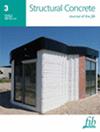评估使用废玻璃粉作为可持续水泥替代品的钢筋混凝土梁的抗剪性能
IF 3.3
3区 工程技术
Q2 CONSTRUCTION & BUILDING TECHNOLOGY
引用次数: 0
摘要
由于缺乏有关无剪切配筋的加筋 GP 混凝土梁剪切性能的全面数据,阻碍了它们的广泛应用,这主要是由于在预测其剪切性能方面存在挑战。本研究探讨了掺入 15% 的废玻璃粉(GP)对两种不同粒径类别的影响:GP-A(55 至 135 μm)和 GP-B(细于 55 μm)作为水泥替代品,对水泥含量不同且无箍筋的钢筋混凝土梁 180 天抗剪性能的影响。为此,共使用了 14 根梁,所有梁的尺寸相同,均为 200 mm × 250 mm × 2000 mm。研究了上述参数对梁剪切性能的影响,包括裂缝模式、破坏模式、荷载-挠度行为以及不同加载阶段的强度能力。此外,这项研究还探讨了最常用的设计规范对预测钢筋 GP 改性混凝土梁抗剪强度的适用性。这些规范通常用于设计无抗剪钢筋的传统钢筋混凝土浅梁的抗剪强度。研究结果表明,在 GP 含量相同的情况下,GP 粒径对梁剪切性能的影响几乎可以忽略不计。此外,研究还发现,在混凝土梁中加入 GP 不会对其开裂承载能力、抗剪强度或抗弯开裂承载能力产生任何负面影响。事实上,它甚至可以提高后者。将实验结果与设计规范的预测结果进行比较后发现,CEB-FIP(1990 年)方程和 ACI 方程都为测试梁提供了安全的剪切强度估计值。不过,与 ACI 方程相比,CEB-FIP(1990)方程得出的预测结果的平均值、标准偏差和变异系数都更低,这表明其估计结果的准确性更高。这些研究结果肯定了 GP 混凝土作为专门设计用于承受剪力的混凝土结构的可行替代品的适用性。本文章由计算机程序翻译,如有差异,请以英文原文为准。
Evaluating the shear performance of reinforced concrete beams using waste glass powder as a sustainable cement substitute
The scarcity of comprehensive data on the shear properties of reinforced GP‐concrete beams without shear reinforcement has hindered their widespread use, mainly due to challenges in predicting their shear performance. This study examines the influence of incorporating up to 15% waste glass powder (GP) with two separate particle size categories: GP‐A (55 to 135 μm) and GP‐B (finer than 55 μm) as a cement replacement on the 180‐day shear performance of reinforced concrete beams with varying cement content and without stirrups. To accomplish this, a total of 14 beams were used, all sharing identical dimensions measuring 200 mm × 250 mm × 2000 mm. The aforementioned parameters were investigated for their effects on the shear performance of beams, including crack patterns, modes of failure, load–deflection behavior, and strength capacities at different loading stages. Furthermore, this investigation explores the applicability of the most commonly used design codes of practice for predicting the shear strength of reinforced GP‐modified concrete beams. These codes are typically employed to design the shear strength of reinforced conventional concrete shallow beams without shear reinforcement. The study's findings indicate that the impact of GP particle size on the shear performance of beams with the same GP content is almost negligible. Additionally, the study found that incorporating GP into concrete beams does not have any negative effects on their cracking load capacity, shear strength, or flexural cracking load capacity. In fact, it can even improve the latter. A comparison of experimental results with predictions from the design codes revealed that both the CEB‐FIP (1990) equation and the ACI equations provided safe estimates of shear strength for the tested beams. However, the CEB‐FIP (1990) equation yielded predictions with a lower mean, standard deviation, and coefficient of variation compared with the ACI equations, suggesting a higher level of accuracy in its estimates. The findings affirm the suitability of GP‐concrete as a viable alternative in concrete structures specifically engineered to withstand shear forces.
求助全文
通过发布文献求助,成功后即可免费获取论文全文。
去求助
来源期刊

Structural Concrete
CONSTRUCTION & BUILDING TECHNOLOGY-ENGINEERING, CIVIL
CiteScore
5.60
自引率
15.60%
发文量
284
审稿时长
3 months
期刊介绍:
Structural Concrete, the official journal of the fib, provides conceptual and procedural guidance in the field of concrete construction, and features peer-reviewed papers, keynote research and industry news covering all aspects of the design, construction, performance in service and demolition of concrete structures.
Main topics:
design, construction, performance in service, conservation (assessment, maintenance, strengthening) and demolition of concrete structures
research about the behaviour of concrete structures
development of design methods
fib Model Code
sustainability of concrete structures.
 求助内容:
求助内容: 应助结果提醒方式:
应助结果提醒方式:


